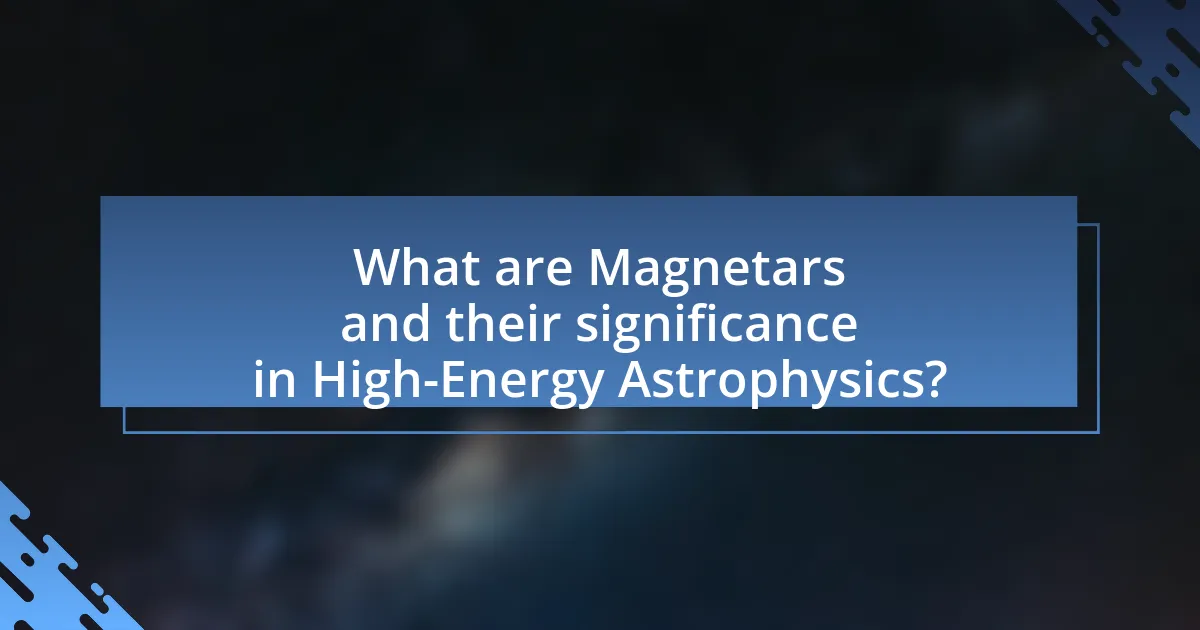Magnetars are a unique type of neutron star known for their extraordinarily strong magnetic fields, which can reach up to 10^15 gauss. Their significance in high-energy astrophysics stems from their ability to emit intense bursts of gamma rays and X-rays, driven by the decay of these magnetic fields. This article explores the distinct properties of magnetars, their role in cosmic evolution, and the mechanisms behind their high-energy emissions. Additionally, it discusses the observational techniques used to study magnetars, the challenges researchers face, and future research directions that could enhance our understanding of these extreme astrophysical objects.

What are Magnetars and their significance in High-Energy Astrophysics?
Magnetars are a type of neutron star characterized by extremely strong magnetic fields, typically around 10^11 to 10^15 gauss, which are among the strongest known in the universe. Their significance in high-energy astrophysics lies in their ability to produce intense bursts of gamma rays and X-rays, driven by the decay of their magnetic fields. This phenomenon allows scientists to study extreme physical conditions and test theories of fundamental physics, including the behavior of matter under extreme gravity and magnetic fields. Observations of magnetars have provided insights into the processes of star formation, supernova explosions, and the nature of neutron star interiors, thereby enhancing our understanding of the universe’s high-energy phenomena.
How do Magnetars differ from other neutron stars?
Magnetars differ from other neutron stars primarily due to their extremely strong magnetic fields, which can exceed 10^15 gauss. This intense magnetism leads to unique phenomena such as high-energy bursts and persistent X-ray emissions, distinguishing them from typical neutron stars that have weaker magnetic fields. For instance, while most neutron stars have magnetic fields around 10^12 gauss, magnetars are capable of producing magnetar flares, which are powerful bursts of gamma rays and X-rays, a behavior not observed in standard neutron stars.
What unique properties define Magnetars?
Magnetars are a type of neutron star characterized by their extremely strong magnetic fields, which can exceed 10^15 gauss. This intense magnetism leads to unique properties such as the emission of high-energy gamma rays and X-rays, particularly during magnetar flares. Additionally, magnetars exhibit rapid rotation, with some rotating several times per second, and they possess a crust that can be unstable due to the immense magnetic pressure. These properties are supported by observations of magnetar activity, such as the 2004 flare from SGR 1806-20, which released more energy in a few seconds than the Sun emits in 10,000 years, demonstrating their extraordinary energy output and magnetic strength.
Why are Magnetars considered extreme astrophysical objects?
Magnetars are considered extreme astrophysical objects due to their extraordinarily strong magnetic fields, which can exceed 10^15 gauss, making them the most magnetic objects in the universe. This intense magnetism leads to unique phenomena, such as the emission of high-energy gamma rays and X-rays, resulting from the release of energy during magnetic field decay. Additionally, magnetars exhibit violent outbursts, including starquakes, which can release more energy in a few seconds than the Sun will emit over its entire lifetime. These characteristics position magnetars at the forefront of high-energy astrophysics, providing insights into the behavior of matter and energy under extreme conditions.
What role do Magnetars play in the universe?
Magnetars play a crucial role in the universe as sources of intense magnetic fields and high-energy emissions. These neutron stars possess magnetic fields that can exceed 10^11 teslas, making them the strongest known magnetic objects. Their magnetic activity leads to the release of enormous amounts of energy, primarily in the form of X-rays and gamma rays, which can influence surrounding space and contribute to cosmic phenomena. For instance, magnetars are believed to be responsible for short-duration gamma-ray bursts, which are among the most energetic events in the universe. This high-energy output provides insights into the behavior of matter under extreme conditions and enhances our understanding of stellar evolution and the life cycles of massive stars.
How do Magnetars influence their surrounding environments?
Magnetars influence their surrounding environments primarily through their intense magnetic fields and high-energy emissions. These magnetic fields, which can exceed 10^11 teslas, are capable of affecting the motion of charged particles in their vicinity, leading to the acceleration of particles and the generation of high-energy radiation, including X-rays and gamma rays. For instance, the magnetar SGR 1806-20 emitted a powerful gamma-ray burst in 2004, which was detected over 50,000 light-years away, demonstrating the far-reaching impact of its emissions. Additionally, the strong magnetic fields can disrupt the surrounding interstellar medium, creating shock waves and influencing star formation processes in nearby regions.
What are the implications of Magnetars on cosmic evolution?
Magnetars significantly influence cosmic evolution through their intense magnetic fields and energetic emissions. These neutron stars, with magnetic fields exceeding 10^11 teslas, can affect their surrounding environments by generating powerful bursts of gamma rays and X-rays, which can trigger star formation in nearby molecular clouds. The energy released during magnetar outbursts contributes to the chemical enrichment of the interstellar medium, impacting the formation and evolution of subsequent generations of stars and planets. Additionally, the violent death of magnetars can lead to supernova explosions, dispersing heavy elements into space, which are essential for the development of complex structures in the universe.

How do Magnetars generate high-energy emissions?
Magnetars generate high-energy emissions through the decay of their intense magnetic fields, which can reach up to 10^15 gauss. This decay releases energy in the form of X-rays and gamma rays, primarily due to the release of magnetic energy as the magnetic field lines twist and snap. Observations have shown that magnetars exhibit bursts of high-energy radiation, often linked to starquakes or sudden changes in their magnetic field configuration, which can release vast amounts of energy in a short time. For instance, the magnetar SGR 1806-20 emitted a burst in 2004 that was one of the most powerful gamma-ray bursts ever recorded, demonstrating the immense energy output associated with these phenomena.
What mechanisms are responsible for Magnetar emissions?
Magnetar emissions are primarily generated by the decay of their intense magnetic fields, which can reach strengths of up to 10^15 gauss. This magnetic field decay leads to the release of vast amounts of energy in the form of X-rays and gamma rays. Additionally, the processes of starquakes, which are sudden shifts in the magnetar’s crust, contribute to these emissions by producing bursts of high-energy radiation. Observations have shown that magnetars can emit bursts that are orders of magnitude more powerful than typical neutron stars, confirming the unique mechanisms at play in their emissions.
How does magnetic field strength affect emission types?
Magnetic field strength significantly influences emission types from astrophysical objects, particularly magnetars. Stronger magnetic fields, such as those exceeding 10^14 gauss in magnetars, lead to the emission of high-energy radiation, including X-rays and gamma rays, due to the acceleration of charged particles in the intense magnetic environment. This phenomenon is supported by observations from the Swift satellite, which detected X-ray bursts from magnetars, confirming that higher magnetic field strengths correlate with increased emission intensity and frequency.
What are the different types of high-energy emissions produced by Magnetars?
Magnetars produce several types of high-energy emissions, primarily including X-rays and gamma rays. These emissions result from the intense magnetic fields, which can exceed 10^14 teslas, leading to the release of energy during magnetic field decay and starquakes. Observations have shown that magnetars can emit bursts of X-rays and gamma rays, with some events reaching luminosities that surpass typical supernovae. For instance, the magnetar SGR 1806-20 emitted a gamma-ray burst in 2004 that was one of the brightest ever recorded, demonstrating the extreme energy output associated with these celestial objects.
Why are Magnetars important for understanding high-energy astrophysics?
Magnetars are crucial for understanding high-energy astrophysics because they are the most magnetic objects in the universe, with magnetic fields exceeding 10^11 teslas. This extreme magnetism leads to unique phenomena such as intense bursts of gamma rays and X-rays, which provide insights into the behavior of matter and energy under extreme conditions. Studies have shown that magnetars can release energy equivalent to that of the Sun in just a few seconds, making them key to exploring the mechanisms of high-energy emissions and the fundamental physics of neutron stars. Their observational data helps refine models of stellar evolution and the dynamics of supernova remnants, thereby enhancing our comprehension of high-energy processes in the cosmos.
How do Magnetars contribute to our knowledge of fundamental physics?
Magnetars enhance our understanding of fundamental physics by providing extreme environments that test theories of gravity, electromagnetism, and nuclear physics. Their intense magnetic fields, which can exceed 10^15 gauss, create conditions that allow scientists to study the behavior of matter and energy under extreme circumstances, such as the effects of strong magnetic fields on particle interactions. Observations of magnetar outbursts and their associated phenomena, like soft gamma repeaters, have led to insights into the nature of neutron stars and the equation of state for ultra-dense matter. These findings contribute to the broader understanding of astrophysical processes and the fundamental forces governing the universe.
What can Magnetars teach us about the behavior of matter under extreme conditions?
Magnetars can teach us about the behavior of matter under extreme conditions by providing insights into the effects of intense magnetic fields and high densities on atomic and subatomic particles. These neutron stars possess magnetic fields that are over a thousand times stronger than those of typical neutron stars, reaching up to 10^15 gauss. This extreme magnetism influences the state of matter, leading to phenomena such as the formation of exotic states of matter, including superconductivity and superfluidity, which are not observable under normal conditions. Observations of magnetar outbursts and their associated emissions, such as X-rays and gamma rays, further reveal how matter behaves under such extreme gravitational and magnetic forces, allowing scientists to test theories of quantum mechanics and general relativity in environments that cannot be replicated on Earth.

What are the observational techniques used to study Magnetars?
The observational techniques used to study magnetars include X-ray and gamma-ray observations, radio astronomy, and optical observations. X-ray and gamma-ray telescopes, such as the Chandra X-ray Observatory and the Fermi Gamma-ray Space Telescope, detect the high-energy emissions from magnetars, which are indicative of their strong magnetic fields and energetic processes. Radio astronomy techniques, including pulsar timing and imaging, allow researchers to study the radio emissions from magnetars, providing insights into their rotation and magnetic properties. Optical observations, although less common, can help in identifying magnetar counterparts and studying their environments. These techniques collectively enhance our understanding of magnetars and their role in high-energy astrophysics.
How do astronomers detect and analyze Magnetar emissions?
Astronomers detect and analyze magnetar emissions primarily through the use of X-ray and gamma-ray telescopes. These instruments are capable of capturing the high-energy radiation emitted by magnetars, which are neutron stars with extremely strong magnetic fields. For instance, the Swift satellite and the Chandra X-ray Observatory have been instrumental in observing magnetar bursts and persistent emissions, allowing researchers to study their characteristics and behavior. The analysis of these emissions involves measuring their intensity, spectrum, and timing, which provides insights into the magnetar’s magnetic field strength and the mechanisms driving its emissions.
What instruments are essential for studying Magnetars?
Essential instruments for studying magnetars include X-ray telescopes, gamma-ray observatories, and radio telescopes. X-ray telescopes, such as the Chandra X-ray Observatory, are crucial for detecting the high-energy emissions from magnetars, while gamma-ray observatories like the Fermi Gamma-ray Space Telescope provide insights into their intense bursts of gamma radiation. Additionally, radio telescopes, such as the Very Large Array, are used to observe the pulsar-like behavior of magnetars, allowing researchers to study their magnetic fields and rotational dynamics. These instruments collectively enable a comprehensive understanding of magnetars’ unique properties and behaviors in the context of high-energy astrophysics.
How do multi-wavelength observations enhance our understanding of Magnetars?
Multi-wavelength observations enhance our understanding of magnetars by providing a comprehensive view of their emission mechanisms and physical properties across different energy ranges. These observations reveal that magnetars emit radiation from radio waves to gamma rays, allowing scientists to study their magnetic fields, rotation rates, and the processes behind their intense bursts. For instance, the detection of X-ray and gamma-ray emissions from magnetars has confirmed their association with strong magnetic fields, exceeding 10^14 gauss, which is crucial for understanding their unique behavior compared to other neutron stars. Additionally, multi-wavelength data helps in identifying the correlation between different emission types, such as the relationship between soft gamma-ray bursts and X-ray flares, thereby deepening insights into the underlying astrophysical processes.
What challenges do researchers face when studying Magnetars?
Researchers face significant challenges when studying magnetars due to their extreme environments and rarity. The intense magnetic fields of magnetars, which can exceed 10^11 teslas, create conditions that are difficult to replicate or observe directly, complicating theoretical modeling and observational strategies. Additionally, magnetars are relatively rare, with only about 30 known in our galaxy, making statistical analysis and comprehensive studies challenging. The high-energy emissions from magnetars, including X-rays and gamma rays, require advanced detection technology and can be obscured by interstellar matter, further complicating observations. These factors collectively hinder the ability to gather consistent data and develop a comprehensive understanding of magnetars’ properties and behaviors.
How do distance and brightness affect Magnetar observations?
Distance and brightness significantly influence Magnetar observations by determining their detectability and the quality of data collected. As the distance from Earth increases, the brightness of a Magnetar decreases due to the inverse square law, making it harder to observe and analyze its emissions. For instance, a Magnetar located 10,000 light-years away appears 100 times dimmer than one at 1,000 light-years, which directly impacts the sensitivity required for detection. Additionally, the brightness of a Magnetar, often measured in terms of its luminosity, affects the range of wavelengths that can be effectively studied; brighter Magnetars can be observed across a wider spectrum, including X-rays and gamma rays, which are crucial for understanding their high-energy processes. Thus, both distance and brightness are critical parameters that shape the observational capabilities and scientific insights gained from studying Magnetars.
What are the limitations of current technologies in Magnetar research?
Current technologies in magnetar research are limited by their inability to detect and analyze high-energy emissions effectively. Instruments such as X-ray and gamma-ray telescopes have sensitivity constraints that hinder the observation of transient magnetar events, which are often brief and unpredictable. Additionally, the spatial resolution of existing telescopes restricts the ability to study magnetars in detail, particularly those located in dense stellar environments. These limitations are compounded by the challenges of data processing and interpretation, as the vast amounts of data generated require advanced algorithms that are still under development.

What future research directions are there for Magnetars in High-Energy Astrophysics?
Future research directions for magnetars in high-energy astrophysics include studying their magnetic field dynamics, understanding their role in gamma-ray bursts, and investigating their potential as sources of gravitational waves. Research indicates that the extreme magnetic fields of magnetars, which can exceed 10^15 gauss, influence their emission mechanisms and could provide insights into fundamental physics (Duncan & Thompson, 1992). Additionally, ongoing observations from facilities like the Chandra X-ray Observatory and the upcoming James Webb Space Telescope will enhance our understanding of magnetar activity and its implications for cosmic evolution.
How might upcoming missions improve our understanding of Magnetars?
Upcoming missions, such as the NASA-led Imaging X-ray Polarimetry Explorer (IXPE) and the European Space Agency’s Athena, are expected to significantly enhance our understanding of magnetars by providing high-resolution observations and detailed polarization measurements. These missions will allow scientists to study the extreme magnetic fields and unique emission mechanisms of magnetars, which are neutron stars with magnetic fields over a trillion times stronger than Earth’s. For instance, IXPE will measure the polarization of X-rays emitted by magnetars, offering insights into their magnetic field structure and the processes occurring in their magnetospheres. Athena will provide unprecedented sensitivity and spatial resolution in the X-ray band, enabling the exploration of magnetar outbursts and their interactions with surrounding matter. Together, these missions will deepen our knowledge of magnetar physics and their role in high-energy astrophysics.
What new technologies are being developed for Magnetar studies?
New technologies being developed for Magnetar studies include advanced telescopes equipped with high-resolution imaging capabilities and sensitive detectors that can capture high-energy emissions. These innovations, such as the use of next-generation gamma-ray observatories like the Cherenkov Telescope Array, enhance the ability to observe and analyze the unique electromagnetic signatures emitted by Magnetars. Additionally, machine learning algorithms are being employed to process vast amounts of data from these observations, allowing for more accurate modeling of Magnetar behavior and characteristics. These advancements are crucial for deepening our understanding of Magnetars’ roles in high-energy astrophysics.
How can interdisciplinary approaches enhance Magnetar research?
Interdisciplinary approaches can enhance Magnetar research by integrating insights from astrophysics, materials science, and computational modeling. This integration allows for a more comprehensive understanding of Magnetar phenomena, such as their magnetic fields and emission mechanisms. For instance, collaboration between astrophysicists and materials scientists can lead to advancements in understanding the extreme states of matter present in Magnetars, as evidenced by studies that explore the behavior of neutron star matter under intense magnetic fields. Additionally, computational modeling techniques from computer science can simulate Magnetar environments, providing predictive insights that are crucial for interpreting observational data. This multifaceted approach ultimately leads to more robust theories and a deeper understanding of Magnetars’ roles in high-energy astrophysics.
What practical insights can we gain from studying Magnetars?
Studying magnetars provides practical insights into extreme astrophysical phenomena, particularly in understanding the behavior of matter and energy under intense magnetic fields. Magnetars possess magnetic fields over a thousand times stronger than typical neutron stars, which allows researchers to explore the effects of these fields on stellar evolution, gamma-ray bursts, and the dynamics of supernova remnants. For instance, the study of magnetar SGR 1806-20 revealed that its magnetic field can influence the surrounding space environment, leading to the emission of high-energy gamma rays, which helps scientists refine models of high-energy astrophysics. Additionally, magnetars serve as natural laboratories for testing theories of fundamental physics, including quantum electrodynamics, under conditions that cannot be replicated on Earth.
How can Magnetar research inform advancements in astrophysics?
Magnetar research can inform advancements in astrophysics by providing insights into extreme magnetic fields and their effects on matter and radiation. These neutron stars possess magnetic fields over a thousand times stronger than typical neutron stars, influencing the behavior of surrounding plasma and emitting high-energy gamma rays and X-rays. Studies of magnetars, such as the 2020 discovery of the magnetar SGR 1935+2154, revealed the potential for understanding the mechanisms behind magnetar flares and their implications for cosmic phenomena. This research enhances knowledge of stellar evolution, supernova mechanisms, and the fundamental physics of matter under extreme conditions, thereby contributing to a deeper understanding of the universe.
What lessons can be learned from Magnetars that apply to other fields of science?
Magnetars teach valuable lessons about extreme magnetic fields and their effects, which can be applied to other scientific fields such as materials science and plasma physics. The study of magnetars reveals how intense magnetic environments can influence particle behavior and energy transfer, providing insights into the properties of superconductors and magnetic materials under extreme conditions. For instance, research indicates that the magnetic fields of magnetars, which can exceed 10^15 gauss, lead to phenomena like magneto-optical effects, which can inform the development of advanced materials with unique electromagnetic properties. Additionally, understanding magnetar emissions can enhance models of high-energy processes in plasma physics, aiding in the comprehension of fusion reactions and astrophysical jets.


